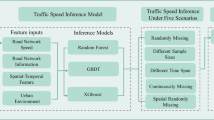Abstract
Traffic flow prediction at the city scale is an important topic useful to many transportation operations and urban applications. However, this is a very challenging problem, affected by multiple complex factors, such as the spatial correlation between different locations and temporal correlation among different time intervals. Considering spatio-temporal correlations, we propose a novel short-term traffic flow prediction model, which combining a gradient–boosted regression tree model and principal component analysis, and we name our model as DSTGBRT. First, we analyze the spatio-temporal correlations among different locations, using Pearson correlation coefficient. Second, we combine Pearson correlation coefficient and historical traffic flow data to construct feature vector and get original training data. Third, to eliminate the linear correlation between features, we use principal component analysis to construct new feature vector and get new training data. In the experiments, compared with traditional spatio-temporal gradient–boosted regression tree model named as STGBRT, the results demonstrate that our proposed DSTGBRT can do a timely and adaptive prediction even in the rush hour when the traffic conditions change rapidly. At the same time, it outperforms the existing methods.
Access this chapter
Tax calculation will be finalised at checkout
Purchases are for personal use only
Similar content being viewed by others
References
Chen, S.Y., Wang, Y., Wu, C.C.: Real-time causal processing of anomaly detection for hyperspectral imagery. IEEE Trans. Aerosp. Electron. Syst. 50(2), 1511–1534 (2014)
Wei, G.: A summary of traffic flow forecasting methods. J. Highway Transp. Res. Dev. 21(3), 82–85 (2004)
Zhang, Y., Zhang, Y., Haghani, A.: A hybrid short-term traffic flow forecasting method based on spectral analysis and statistical volatility model. Transp. Res. Part C: Emerg. Technol. 43, 65–78 (2014)
Yao, B., Chen, C., Cao, Q.: Short-term traffic speed prediction for an urban corridor. Comput.-Aided Civil Infrastruct. Eng. 32(2), 154–169 (2016)
Zheng, C., Xianfu, C.: The model of short term traffic flow prediction based on the random forest. Microcomput. Appl. 35(10), 46–49 (2016)
Zhang, Y., Haghani, A.: A gradient boosting method to improve travel time prediction. Transportation Research Part C: Emerging Technologies 58, 308–324 (2015)
Faming, Z.: Urban link travel time prediction based on a gradient boosting method considering spatiotemporal correlations. ISPRS Int. J. Geo-Inf. 5(11), 201–229 (2016)
Ding, C., Wang, D., Ma, X.: Predicting short-term subway ridership and prioritizing its influential factors using gradient boosting decision trees. Sustainability 8(11), 1100–1115 (2016)
Polikar, R.: Ensemble based systems in decision making. IEEE Circuits Syst. Mag. 6(3), 21–45 (2006)
Soper, H.E., Young, A.W., Cave, B.M., Lee, A., Pearson, K.: On the distribution of the correlation coefficient in small samples. Appendix II to the papers of Student. Biometrika 11, 328–413 (1917)
Liu, Y., Kang, C., Gao, S., Xiao, Y., Tian, Y.: Understanding intra-urban trip patterns from taxi trajectory data. J. Geogr. Syst. 14, 463–483 (2012)
Liu, X., Gong, L., Gong, Y., Liu, Y.: Revealing travel patterns and city structure with taxi trip data. J. Transp. Geogr. 43, 78–90 (2013)
Zhang, F., Zhu, X., Guo, W., Ye, X., Hu, T., Huang, L.: Analyzing urban human mobility patterns through a thematic model at a finer scale. ISPRS Int. J, Geo-Inf (2016)
Acknowledgments
This work was supported by the National Key R&D Program of China (No. 2017YFC0212103), Key R&D Program of Chongqing (No. cstc2018jszx-cyztzxX0019), Ford University Research Program (No. DEPT2018-J030.1).
Author information
Authors and Affiliations
Corresponding author
Editor information
Editors and Affiliations
Rights and permissions
Copyright information
© 2019 Springer Nature Switzerland AG
About this paper
Cite this paper
Yang, J., Zheng, L., Sun, D. (2019). Urban Traffic Flow Prediction Using a Gradient-Boosted Method Considering Dynamic Spatio-Temporal Correlations. In: Douligeris, C., Karagiannis, D., Apostolou, D. (eds) Knowledge Science, Engineering and Management. KSEM 2019. Lecture Notes in Computer Science(), vol 11776. Springer, Cham. https://doi.org/10.1007/978-3-030-29563-9_25
Download citation
DOI: https://doi.org/10.1007/978-3-030-29563-9_25
Published:
Publisher Name: Springer, Cham
Print ISBN: 978-3-030-29562-2
Online ISBN: 978-3-030-29563-9
eBook Packages: Computer ScienceComputer Science (R0)




